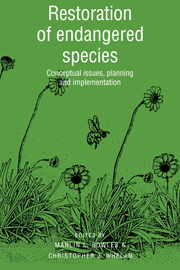III - Implemented restorations
Published online by Cambridge University Press: 27 January 2010
Summary
This section describes four currently implemented restorations, although they vary widely in their progress. Factors such as persecution (e.g., collecting, hunting, trapping), habitat loss, small population size and associated problems such as inbreeding, susceptibility to disease, and incompatible mating types, contributed to the initial decline of the species in question. Translocations, captive propagation, population viability analysis, metapopulation theory, dedication, and long-term commitment are among the factors contributing to each restoration attempt. We read of both interagency cooperation, and interagency feuding and mistrust.
Carbyn et al. (Chapter 10), Clark (Chapter 11), and DeMauro (Chapter 12) provide historical sketches of the decline of the species in question, followed by a description of the restoration effort. In contrast, Pavlik (Chapter 13) first describes two powerful demographic monitoring techniques, and follows with a description of a preliminary restoration effort that demonstrates their utility.
Of these examples, the restoration of swift foxes described by Carbyn et al. has been in operation for the longest time, and this effort appears to have established self-maintaining populations. They show better survival of swift foxes when they are released in the fall, when natal dispersal normally takes place, and better survival of translocated rather than captive-reared foxes. Given this last finding, it is fortunate that healthy populations of swift fox exist in several states within its range in the United States, and that cooperation among state, provincial, and two federal governments has been possible.
- Type
- Chapter
- Information
- Restoration of Endangered SpeciesConceptual Issues, Planning and Implementation, pp. 243 - 246Publisher: Cambridge University PressPrint publication year: 1994



